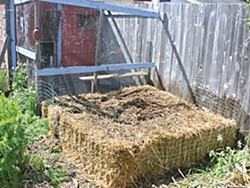[
{
"name": "Top Stories Video Pair",
"insertPoint": "7",
"component": "17087298",
"parentWrapperClass": "fdn-ads-inline-content-block",
"requiredCountToDisplay": "1"
}
]
In the last few years, I have almost given up on vegetable gardening. When I moved to Eureka, I laid out my backyard with the intention of growing almost exclusively fruits and vegetables. Sure, there would be a border of perennial herbs and flowers, but I wanted the main attraction to be neat rows of vegetable beds planted with salad greens, beets, potatoes, onions and tomatoes. But through some combination of laziness and battle fatigue, I gave up. The perennials won over. My produce came from the farmers' market, which turned out to be, for me, a far superior method of procuring fresh organic produce. Let the farmers in Willow Creek grow tomatoes, where the right combination of warm sunshine and expertise allows them to produce far better Brandywines than I ever have in my own backyard.
But I just got back from a trip to the East Coast, where spring arrives abruptly and lures gardeners outside to participate in the annual rite known as putting in a vegetable garden. I visited several gardening friends in upstate New York and Connecticut, and every one of them was consumed with their plans for heaping a layer of compost on their vegetable beds and sowing the first round of seeds. They all seemed so confident in what they were doing, and why shouldn't they be? This was an annual tradition. Every year around this time, the warm weather arrives, the sun comes out, the seeds go in the ground and before long they are eating out of their backyards.
It made me realize how much I missed this annual ritual. My own backyard harvests have been so sporadic over the years. I forget to water, I don't protect seedlings from the wind in late spring, I don't keep the snails or the weeds under control, and I have yet to figure out a good way to keep the chickens from raiding the lettuce bed. But this year, I'm going to give it another try. I have a plan.
Seattle Tilth had an exhibit at a garden show a few years ago in which they demonstrated how to plant a straw bale garden. The idea was to take what is essentially a waste product — bales of rice straw — and use them to create raised beds. The bales come tightly packed and tied with string, and all you do is pull some of the straw out of the center of each bale and fill it with compost and potting soil. Plant right into the bale, and water the whole thing with a weak solution of compost tea and liquid organic fertilizer. The plants roots may wander out of the soil and into the rice straw itself, which is fine as long as the whole thing is getting watered and fed. At the end of the season, cut the strings and allow the whole thing — straw, soil and what's left of the plants — to compost throughout the winter.
That's it. No weeds, no digging, and if you start with fresh potting soil every year you won't have to worry about soil-borne diseases building up over time. (This is a particular concern for tomatoes — typically gardeners are advised to rotate their tomato patch to a different location every year, but this isn't easy to do in a small garden with only one or two sunny spots to choose from.)
The bales measure about four feet long and two feet wide, so I'm starting with four to six bales, which I'm positioning against a sunny-south facing fence. (The bales are available at feed stores for under seven bucks each; rice straw is supposed to be better than hay because hay can contain seed that will sprout.) I'm going to wrap a few extra pieces of twine around them to make sure they don't fall apart, and run a drip irrigation or soaker hose line out to them to make absolutely sure they don't dry out. (This also makes it easier for someone else to water if I'm out of town — it can even be put on a timer.) I've also considered driving a few stakes into the bales to support a low chicken fence or to provide support for floating row covers, which will help protect seedlings from wind and cooler temperatures.
I don't know how this experiment will go. Most of the bold new initiatives I attempt in my garden fall apart eventually, so I guess I ought to admit that this one will too. But there's something about the arrival of spring, and the sight of all my East Coast friends getting outside to put their vegetable garden in at last. It's a ritual I can't help but want to take part in. I'll report back and let you know how it goes. And if you've ever tried a straw bale garden, drop me a line and give me some advice. I can use all the help I can get.
Comments
Showing 1-1 of 1
more from the author
-
NCJ Archive: Bring on the Bugs
- Oct 28, 2020
-
Cocktail Garden Crazy Talk
- Jun 13, 2013
-
Now You're Pushing It
- May 9, 2013
- More »
































